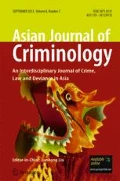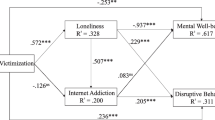Abstract
Digital piracy is a global concern for society. Although adolescents’ digital piracy in South Korea is pervasive, its cause has rarely been examined. Using data collected by the Korean Institute of Criminology (KIC) in 2009, this study conducted structural equation modeling to determine if low self-control and social learning theory accounted for digital piracy. This study found that parental indifference increased adolescents’ digital piracy through low self-control and misconception about digital piracy. However, there were no direct effects of parental indifference on the digital piracy behaviors. In particular, the mediation effect in the model combining low self-control and misconception was greater compared to other models. Overall, the combination of low self-control and social learning theory provided a more meaningful framework to explain adolescents’ digital piracy. Results of this study can offer ways to aid in the examination and remediation of this particular form of deviant behaviors on the Internet by adolescents.
Similar content being viewed by others
Notes
Thirteen countries: Australia, Brazil, Canada, France, Germany, Great Britain, Italy, Japan, Mexico, South Korea, Spain, Sweden, and USA (IFPI, 2015).
To our knowledge, this study that explained digital piracy using low self-control and social learning theories was only a known research paper in South Korea.
[Situation] Minsu’s listening to music on the Internet
Minsu learned about a P2P site while surfing the Web. On P2P sites, there are various files, such as the latest music, movies, cartoons, and programs that people could hear or see comfortably at home. Although people need to pay for the files, they are using without payment. Minsu uploaded the music files to his blog to share the music with his friend, Eunji. She downloaded the music from his blog and listen to the music, even she knew the music file came from the website.
Cheung and Rensvold (2002) proposed the .01 cutoff point of ΔCFI value. That is, more than .01 change will be significant.
References
Akers, R. L. (1985). Deviant Behavior: A Social Learning Approach. Belmont, DA: Wadsworth.
Akers, R. L. (1998). Social Learning and Social Structure: A General Theory of Crime and Deviance. Boston, MA: Northeastern University Press.
Baek, H., Losavio, M. M., & Higgins, G. E. (2016). The impact of low self-control on online harassment: Interaction with opportunity. Journal of Digital Forensic, Security, and Law, 11, 27–42.
Bandura, A. (1986). The explanatory and predictive scope of self-efficacy theory. Journal of Social and Clinical Psychology, 4(3), 359–373.
Bhattacharjee, S., Gopal, R. D., & Sanders, G. L. (2003). Digital music and online sharing: Software piracy 2.0? Communications of the ACM, 46(7), 107–111.
Belson, D. (2016). Akamai’s State of the Internet: Q1 2016 Report. Retrieved on May 29, 2017, from https://www.akamai.com/us/en/multimedia/documents/state-of-the-internet/q4-2016-state-of-the-internet-connectivity-report.pdf
Business Software Alliance (2012). Shadow market: 2011 BSA global software piracy study, 9th edn. Retrieved November 11, 2015, from Business software alliance Web site:http://portal.bsa.org/globalpiracy2011/downloads/study_pdf/2011_BSA_Piracy_Study-Standard.pdf
Cheung, G. W., & Rensvold, R. B. (2002). Evaluating goodness-of-fit indexes for testing measurement invariance. Structural Equation Modeling, 9, 233–255.
Cho, H. (2010). 2010 police statistical yearbook. Seoul, Korea: Korean National Police Agency Press.
Choi, S. (2009). A study of cybercrime among juveniles. Seoul, Korea: Korean Institute of Criminology.
Cochran, J. K., Wood, P. B., Sellers, C. S., Wilkerson, W., & Chamlin, M. B. (1998). Academic dishonesty and low self-control: An empirical test of a general theory of crime. Deviant Behavior, 19, 227–255.
Daniel, A. J. (2005). Adolescent’s perceptions of deviance when using technology: The approaching post-typographic culture. Online Submission, 11(1), 19–24.
Desmond, S. A., Bruce, A. S., & Stacer, M. J. (2012). Self-control, opportunity, and substance use. Deviant Behavior, 33, 425–447.
Donner, C. M., & Jennings, W. G. (2014). Low self-control and police deviance: Applying Gottfredson and Hirschi’s general theory to officer misconduct. Police Quarterly, 17, 203–225.
Donner, C. M., Marcum, C. D., Jennings, W. G., Higgins, G. E., & Banfield, J. (2014). Low self-control and cybercrime: Exploring the utility of the general theory of crime beyond digital piracy. Computers in Human Behavior, 34, 165–172.
Evans, T. D., Cullen, F. T., Burton, V. S., Dunaway, R. G., & Benson, M. L. (1997). The social consequences of self-control: Testing the general theory of crime. Criminology, 35(3), 475–504.
Festinger, L., Pepitone, A., & Newcomb, B. (1952). Some consequences of deindividuation in a group. Journal of Abnormal and Social Psychology, 47, 382–389.
Gibbs, J. J., Giever, D., & Martin, J. S. (1998). Parental management and self-control: An empirical test of Gottfredson and Hirschi’s general theory. Journal of Research in Crime and Delinquency, 35(1), 40–70.
Gottfredson, M., & Hirschi, T. (1987). The methodological adequacy of longitudinal research on crime. Criminology, 25(3), 581–614.
Gottfredson, M., & Hirschi, T. (1990). A general theory of crime. Stanford, CA: Stanford University Press.
Higgins, G. E. (2004). Can low self-control help understand the software piracy problem? Deviant Behavior, 26(1), 1–24.
Higgins, G. E. (2006). Gender differences in software piracy: The mediating roles of self-control theory and social learning theory. Journal of Economic Crime Management, 4, 1–30.
Higgins, G. E., Fell, B. D., & Wilson, A. L. (2006). Digital piracy: Assessing the contributions of an integrated self-control theory and social learning theory using structural equation modeling. Criminal Justice Studies, 19, 3–22.
Higgins, G. E., Fell, B. D., & Wilson, A. L. (2007). Low self-control and social learning in understanding students’ intentions to pirate movies in the United States. Social Science Computer Review, 25, 339–357.
Higgins, G. E., & Makin, D. A. (2004). Does social learning theory condition the effects of low self-control on college students’ software piracy. Journal of Economic Crime Management, 2(2), 1–22.
Higgins, G. E., Wolfe, S. E., & Marcum, C. D. (2008). Digital piracy: An examination of three measurements of self-control. Deviant Behavior, 29, 440–460.
Hinduja, S. (2008). Deindividuation and internet software piracy. Cyberpsychology & Behavior, 11(4), 391–398.
Hoeve, M., Dubas, J. S., Eichelsheim, V. I., van der Laan, P. H., Smmenk, W., & Gerris, J. R. M. (2009). The relationship between parenting and delinquency: A meta-analysis. Journal of Abnormal Child Psychology, 37, 749–775.
Hollinger, R. C. (1992). Crime by computer: Correlates of software piracy and unauthorized account access. Security Journal, 4(1), 2–12.
Holt, T. J., Bossler, A. M., & May, D. C. (2012). Low self-control, deviant peer associations, and juvenile cyber deviance. American Journal of Criminal Justice, 37(3), 378–395.
Hu, L. T., & Bentler, P. M. (1999). Cutoff criteria for fit indexes in covariance structure analysis: Conventional criteria versus new alternatives. Structural Equation Modeling: A Multidisciplinary Journal, 6(1), 1–55.
International Federation of the Phonographic Industry. (2015). IFPI Digital Music Report 2015: Charting the Path to Sustainable Growth. May 29, 2017, from http://www.ifpi.org/downloads/Digital-Music-Report-2015.pdf
Kline, R. B. (2016). Principles and practice of structural equation modeling (4th ed.). New York: The Guilford Press.
Kim, J. E., & Kim, J. H. (2015). Software piracy among Korean adolescents: Lessons from panel data. Deviant Behavior, 36, 705–724.
Kim, K., Ryu, E., Chon, M. Y., Yeun, E. J., Choi, S. Y., Seo, J. S., & Nam, B. W. (2006). Internet addiction in Korean adolescents and its relation to depression and suicidal ideation: A questionnaire survey. International Journal of Nursing Studies, 43(2), 185–192.
Korean National Police Agency. (2014). 2014 white paper. Seoul, Korea: Korean National Police Agency Press.
Korean National Police Agency. (2015). 2015 white paper. Seoul, Korea: Korean National Police Agency Press.
Lee, C. (2015). 2015 police statistical yearbook. Seoul, Korea: Korean National Police Agency Press.
Lee, S. (2011). Independent and interaction effects of low self-control and social learning variables on youth’s online digital piracy. Korean Journal of Youth Studies, 18, 123–142.
Marcum, C. D., Higgins, G. E., Wolfe, S. E., & Ricketts, M. L. (2011). Examining the intersection between self-control, peer association, and neutralization in explaining digital piracy. Western Criminology Review, 12(3), 60–74.
Malin, J., & Fowers, B. J. (2009). Adolescent self-control and music and movie piracy. Computers in Human Behavior, 25, 718–722.
Moon, B., McCluskey, J. D., & McCluskey, C. P. (2010). A general theory of crime and computer crime: An empirical test. Journal of Criminal Justice, 38, 767–772.
Moon, B., McCluskey, J. D., McCluskey, C. P., & Lee, S. (2013). Gender, general theory of crime and computer crime: An empirical test. International Journal of Offender Therapy and Comparative Criminology, 57(3), 460–478.
Morris, R. G., & Higgins, G. E. (2009). Neutralizing potential and self-reported digital piracy: A multi-theoretical exploration among college undergraduates. Criminal Justice Review, 34, 173–195.
Morris, R. G., Johnson, M. C., & Higgins, G. E. (2009). The role of gender in predicting the willingness to engage in digital piracy among college students. Criminal Justice Studies, 22(4), 393–404.
Navarro, J. N., Marcum, C. D., Higgins, G. E., & Ricketts, M. L. (2016). Addicted to the thrill of the virtual hunt: Examining the effects of internet addiction on the cyberstalking behaviors of juveniles. Deviant Behavior, 37(8), 893–903.
Park, S. (2009). The association between Internet use and depressive symptoms among South Korean adolescents. Journal for Specialists in Pediatric Nursing, 14, 230–238.
Park, S. K., Kim, J. Y., & Cho, C. B. (2009). Prevalence of Internet addiction and correlations with family factors among South Korean adolescents. Family Therapy, 36, 163–177.
Phau, I., & Liang, J. (2012). Downloading digital video games: Predictors, moderators and consequences. Marketing Intelligence & Planning, 30(7), 740–756.
Pratt, T. C., & Cullen, F. (2000). The empirical status of Gottfredson and Hirschi’s general theory of crime: A meta-analysis. Criminology, 38, 931–964.
Ramayah, T., Ahmad, N. H., Chin, L. G., & Lo, M. C. (2009). Testing a causal model of internet piracy behavior among university students. European Journal of Scientific Research, 29(2), 206–214.
Robertson, K., McNeill, L., Green, J., & Roberts, C. (2012). Illegal downloading, ethical concern, and illegal behavior. Journal of Business Ethics, 108(2), 215–227.
Schumacker, R. E., & Lomax, R. G. (1996). A beginner guide to structural equation modeling. Mahwah, NJ: Erlbaum.
Simmons, L. C. (2004). An exploratory analysis of software piracy using cross-cultural data. International Journal of Technology Management, 28(1), 139–148.
Siwek, S. E. (2007). The true cost of sound recording piracy to the U.S. economy. Retrieved April 20, 2017, from Institute for Policy Innovation Web site: http://www.ipi.org/docLib/20120515_SoundRecordingPiracy.pdf
Skinner, B. F. (1953). Science and human behavior. Simon and Schuster.
Skinner, W. F., & Fream, A. M. (1997). A social learning theory analysis of computer crime among college students. Journal of Research in Crime and Delinquency, 34(4), 495–518.
Statista. (2017). Statistics and facts about internet usage in South Korea. Retrieved May 29, 2017, from The Statistics Portal https://www.statista.com/topics/2230/internet-usage-in-south-korea/
Sutherland, E. H., & Cressey, D. R. (1974). Criminology (9th ed.). Philadelphia, PA: JB Lippincot.
The Economist. (2011). Illegal downloading and media investment: Spotting the pirates. Retrieved May 29, 2017, from http://www.economist.com/node/21526299
Winfree Jr., L. T., & Bernat, F. P. (1998). Social learning, self-control, and substance abuse by eighth grade students: A tale of two cities. Journal of Drug Issues, 28(2), 539–558.
Wolfe, S. E., Higgins, G. E., & Marcum, C. D. (2008). Deterrence and digital piracy: A preliminary examination of the role of viruses. Social Science Computer Review, 26(3), 317–333.
Yun, Y., Ji, H., & Lim, H. (2016). A study on the analysis of factors that influence Internet usage of adolescence. The Journal of Korean Association of Computer Education, 19, 55–71.
Author information
Authors and Affiliations
Corresponding author
Ethics declarations
Data is accessible from the Korean Social Science Data Archive (data code: A1-2009-0119), which is a non-profit social science data archive established by integrating the Korea Social Science Library and the Korean Social Survey Data Archive.
Furthermore, the data was approved by Institutional Review Board in the University of Louisville (IRB number: 15.1093). Ethical problem and informed consent are not issues for this manuscript.
Conflict of Interest
This manuscript does not have potential conflicts of interest because this study used an existing secondary data.
Rights and permissions
About this article
Cite this article
Baek, H., Nicholson, J.A., Higgins, G.E. et al. Parental Indifference and Children’s Digital Piracy in South Korea: Mediation Effects of Low Self-Control and Misconception. Asian J Criminol 13, 293–309 (2018). https://doi.org/10.1007/s11417-018-9271-3
Received:
Accepted:
Published:
Issue Date:
DOI: https://doi.org/10.1007/s11417-018-9271-3




